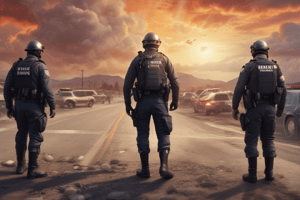Podcast
Questions and Answers
What is a Crisis Situation according to SOP 522.00?
What is a Crisis Situation according to SOP 522.00?
- A situation where a police officer is involved in a hostage situation
- A situation where an individual or a group poses a threat to only themselves
- A situation when an individual or a group poses a danger to themselves or others (correct)
- A situation where a individual or group is involved in a peaceful protest
Who is responsible for initiating and or sustaining a crisis situation?
Who is responsible for initiating and or sustaining a crisis situation?
- The District Shift Commander
- The Crisis Principal (correct)
- The First Supervisor on the scene
- The Tactical Commander
What should the First Supervisor on the scene do first?
What should the First Supervisor on the scene do first?
- Direct responding units to a command location
- Initiate a written log of actions taken
- Evaluate the situation and modify or affirm back-up requirements (correct)
- Attempt to establish a line of communication with the Crisis Principal
Why should initial contact with the Crisis Principal not be by a ranking officer if possible?
Why should initial contact with the Crisis Principal not be by a ranking officer if possible?
Who should approve the contact of family members, friends, or any other person associated with the Crisis Principal with the Crisis Principal?
Who should approve the contact of family members, friends, or any other person associated with the Crisis Principal with the Crisis Principal?
What should the CNT negotiator refrain from making without approval of the Tactical Commander?
What should the CNT negotiator refrain from making without approval of the Tactical Commander?
What must be approved by the Tactical Commander or their designee?
What must be approved by the Tactical Commander or their designee?
What is not negotiable in a crisis situation?
What is not negotiable in a crisis situation?
The Crisis Principal is the person or persons responsible for responding to a crisis situation.
The Crisis Principal is the person or persons responsible for responding to a crisis situation.
The First Supervisor on the scene is responsible for establishing a perimeter around the incident scene.
The First Supervisor on the scene is responsible for establishing a perimeter around the incident scene.
The Tactical Commander is responsible for documenting all demands made by the Crisis Principal.
The Tactical Commander is responsible for documenting all demands made by the Crisis Principal.
Family members, friends, or any other person associated with the Crisis Principal can be put in direct contact with the Crisis Principal without approval.
Family members, friends, or any other person associated with the Crisis Principal can be put in direct contact with the Crisis Principal without approval.
The CNT negotiator can make promises to the Crisis Principal without approval of the Tactical Commander.
The CNT negotiator can make promises to the Crisis Principal without approval of the Tactical Commander.
Exchange of persons for hostages is negotiable in a crisis situation.
Exchange of persons for hostages is negotiable in a crisis situation.
The Tactical Commander or their designee is responsible for approving all negotiated items.
The Tactical Commander or their designee is responsible for approving all negotiated items.
The District Shift Commander is responsible for initiating a written log of actions taken at the scene.
The District Shift Commander is responsible for initiating a written log of actions taken at the scene.
Flashcards are hidden until you start studying
Study Notes
Crisis Situations
- A crisis situation occurs when an individual or group poses a danger to themselves or others, e.g., suicide attempts, hostage situations, active shooters, and armed/barricaded subjects.
Roles and Responsibilities
- Tactical Commander: The Homeland Security Division Commander or their designee responsible for tactical operations at the scene.
- Crisis Principal: The person or persons responsible for initiating and/or sustaining a crisis situation.
Initial Response
- The first supervisor on the scene shall:
- Evaluate the situation and modify or affirm backup requirements.
- Direct responding units to a command location or vehicle marshaling area.
- Advise the District Shift Commander of circumstances via secure communications.
- Initiate a written log of actions taken.
- Ensure the incident scene is secure and establish a perimeter.
- Attempt to establish a line of communication with the Crisis Principal if communication has not been established prior to arrival.
Communication with Crisis Principal
- Initial contact with the Crisis Principal should not be by a ranking officer if possible.
- During initial contact, family members, friends, or any other person associated with the Crisis Principal or Hostage Taker shall not be put in direct contact with the Crisis Principal unless approval has been given by the CNT Team Leader.
Negotiation and Demands
- All demands made by the Crisis Principal or Hostage Taker shall be documented and provided to the CNT Team Leader upon their arrival.
- Documentation shall include demands, time of demands, deadline for demands, any promises made, etc.
- The CNT negotiator shall refrain from making false promises to the Crisis Principal without approval of the Tactical Commander.
- All negotiated items must be approved by the Tactical Commander or their designee.
- All items are negotiable except for weapons and exchange of persons for hostages.
Crisis Situations
- A crisis situation occurs when an individual or group poses a danger to themselves or others, e.g., suicide attempts, hostage situations, active shooters, and armed/barricaded subjects.
Roles and Responsibilities
- Tactical Commander: The Homeland Security Division Commander or their designee responsible for tactical operations at the scene.
- Crisis Principal: The person or persons responsible for initiating and/or sustaining a crisis situation.
Initial Response
- The first supervisor on the scene shall:
- Evaluate the situation and modify or affirm backup requirements.
- Direct responding units to a command location or vehicle marshaling area.
- Advise the District Shift Commander of circumstances via secure communications.
- Initiate a written log of actions taken.
- Ensure the incident scene is secure and establish a perimeter.
- Attempt to establish a line of communication with the Crisis Principal if communication has not been established prior to arrival.
Communication with Crisis Principal
- Initial contact with the Crisis Principal should not be by a ranking officer if possible.
- During initial contact, family members, friends, or any other person associated with the Crisis Principal or Hostage Taker shall not be put in direct contact with the Crisis Principal unless approval has been given by the CNT Team Leader.
Negotiation and Demands
- All demands made by the Crisis Principal or Hostage Taker shall be documented and provided to the CNT Team Leader upon their arrival.
- Documentation shall include demands, time of demands, deadline for demands, any promises made, etc.
- The CNT negotiator shall refrain from making false promises to the Crisis Principal without approval of the Tactical Commander.
- All negotiated items must be approved by the Tactical Commander or their designee.
- All items are negotiable except for weapons and exchange of persons for hostages.
Studying That Suits You
Use AI to generate personalized quizzes and flashcards to suit your learning preferences.




